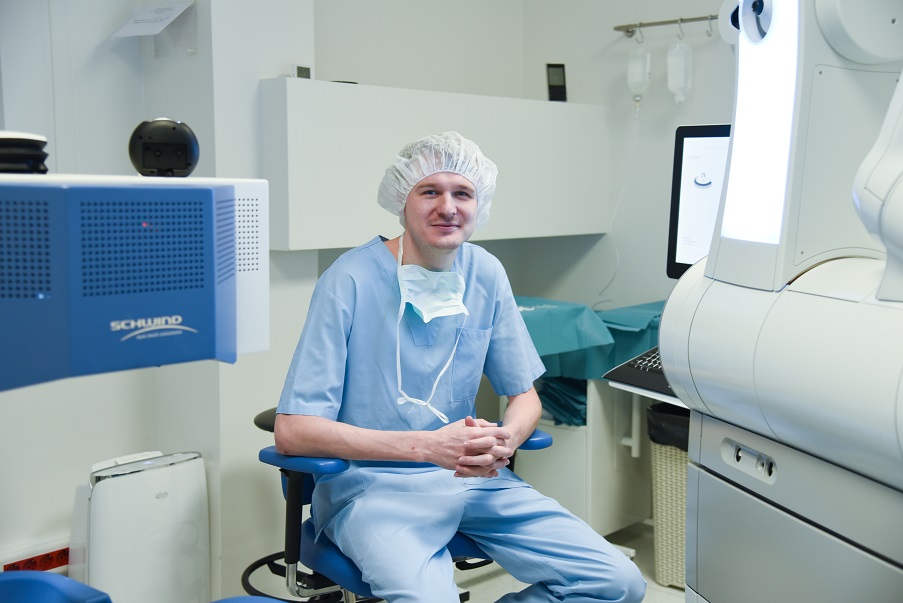A novelty just a few decades ago, laser eye surgery has now become one of the three standard options for vision correction. In most cases, it is a real salvation for those who live an active life or cannot tolerate eyeglasses or contact lenses. Various methods of laser eye surgery can be found. How are they different, and how do you know which one is best?
According to a microsurgeon at Lirema Eye Clinic Šarūnas Sologubovas, safety is the main factor in deciding which laser eye surgery method to choose for a patient.
“Before the procedure, detailed eye examinations of the patient are carried out, we discuss what his lifestyle is, what eye or related diseases he suffers from, then based on the information collected and the results of the examinations, it is assessed which method would be most suitable for the patient. If several are available, the patient chooses the one that is acceptable to him,” says the microsurgeon.
The most popular method in the Baltics
Often, due to the different titles on the market, it is difficult for the patient to distinguish one method from another and to compare them, especially if the prices of the procedures differ.
“Laser eye surgery methods are basically divided into two groups: surface procedure, with a longer postoperative recovery period, and performed in the deep layers of the cornea when the healing period is extremely short. The group of surface correction methods includes the so-called PRK, SMARTSURFace (or transPRK), LASEK methods, and the short postoperative period procedures – LASIK, femtoLASIK (or FS LASIK) and a novelty on the market – SMILE procedure”, – points out Š. Sologubovas.
In Baltic countries, patients usually choose surface laser eye surgery methods, decide to spend a few days at home and devote time to postoperative vision recovery. The effect of this type of surgery is achieved within a few weeks.
According to microsurgeon Š. Sologubovas, in the case of surface vision correction, the upper layer of the epithelium is removed, the surface part of the cornea is directly affected by the excimer laser, the laser beam flattens and forms the required shape of the cornea, and vision is improved.
“Imagine that you have scratched your skin – it needs some time to heal, to regrow a new layer. Surface laser eye surgery works on exactly the same principle – during the first few postoperative days, a new layer of epithelium grows, and the surface of the cornea heals. Temporary protective contact lenses are placed to speed up and facilitate healing,” says the doctor.
According to him, the surface laser eye surgery procedure is completely painless, but few avoid the discomfort of postoperative healing.
“To make these few days as easy as possible for the patients, all the medicines needed during the post-operative healing are given. With good pain tolerance, patients feel better, but there is no need to hope that while the body is working to grow a new layer of cells, you will not feel anything – your eyes may water and itch, and you will want to avoid the light”, shares his experience Šarūnas Sologubovas.
For those who don’t have time – a quick way out
Some patients hope for a quick result or do not tolerate pain at all, so a longer recovery period can be a challenge. In this case, with the help of improving technologies, operations are performed using femtoLASIK (FS LASIK) or SMILE methods, which are particularly popular with Scandinavians.
According to the ophthalmologist, in the case of FS LASIK laser eye surgery, one laser (femtosecond) is used to shape and lift the corneal flap, another laser (excimer) acts on and flattens the surface inner part of the cornea and the flap is returned back. This is one of the most popular correction methods worldwide. It is important not to confuse this method of vision correction with LASIK performed with a mechanical microkeratome, which was replaced by the femtosecond laser a decade ago.
“When performing FEMTO laser eye surgery, the cornea’s surface layer is preserved, and the eyes heal quickly. The full effect is achieved in just a few days without losing working capacity. “Baltic countries patients look a little more cautiously at this type of procedure because of the additional step in forming the patch, but it has been on the market for many years, and if it were not so reliable and safe, it would not be so widely performed,” asserts Š. Sologubovas.
According to the doctor, the most comfortable option is laser eye surgery using the SMILE method, which ensures extremely fast eye healing while preserving the integrity of the corneal tissue and maximally reducing discomfort due to dry eyes after laser correction.
“This type of vision correction minimally affects the cornea, so the patient can not only avoid dry eyes but can immediately return to the rhythm of normal life, engage in contact sports and enjoy freedom without glasses and contact lenses,” the microsurgeon mentions the differences.
Neither type of laser eye surgery is better or worse than the other because the final result of vision correction is the same with any method; the only difference is the time of the postoperative period and the operation technique.
“Patients often want to choose the best method, but none exists. The best one is the one that is most suitable for a specific patient according to the health and eye condition, is safe and ensures maximum good vision for as long as possible”, sums up Š. Sologubovas.
Find out whether laser eye surgery is available for you online.
